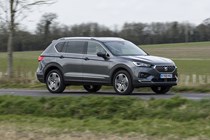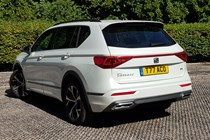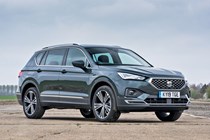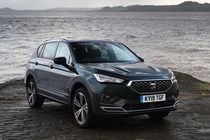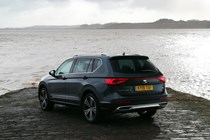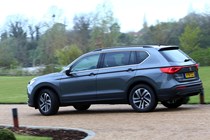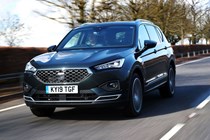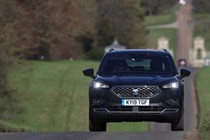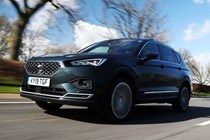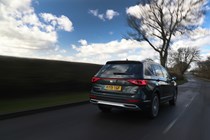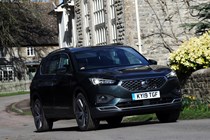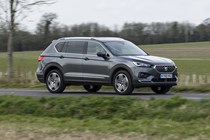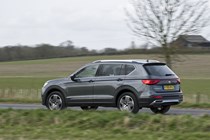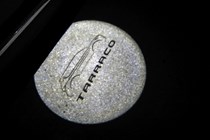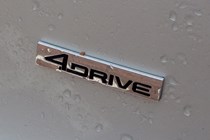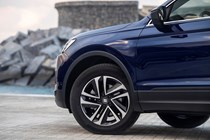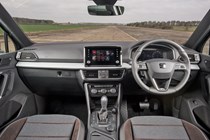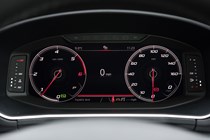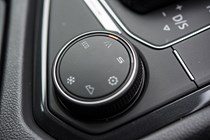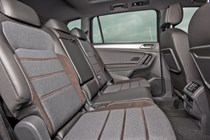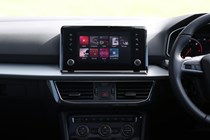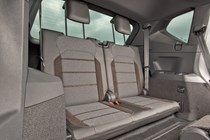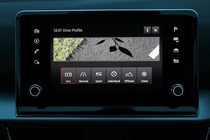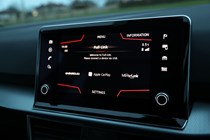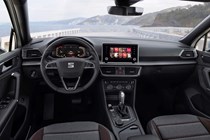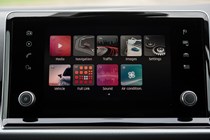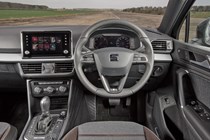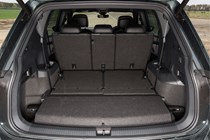
SEAT Tarraco long-term test

Welcome to the Parkers long-term test of the SEAT Tarraco MPV. Read on the find out what it’s like to live with one of these seven-seater SUVs as CJ Hubbard subjects it to his young family.
Update 1: Hello SEAT Tarraco Xcellence 2.0-litre TDI 150 DSG 4Drive
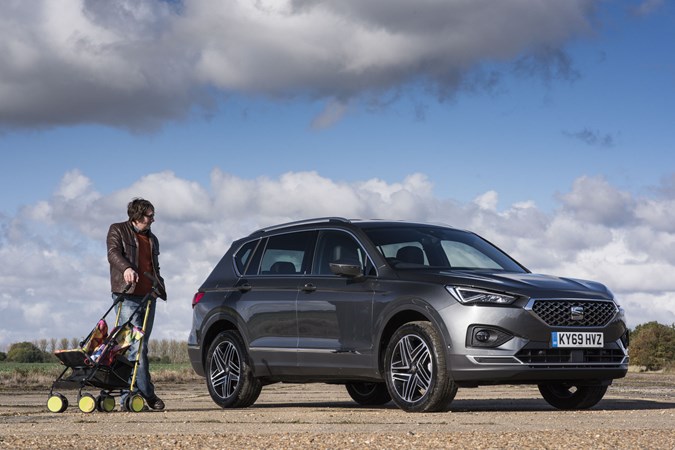
I guess it was inevitable: I have moved from a family estate car – my previous long-termer, a Mazda 6 Tourer – into a family SUV. This SEAT Tarraco is my new ‘Dad car’, and my chance to find out whether a big 4x4 really is the answer that so many buyers seem to think it is these days.
What’s the spec?
A pretty sound one for winter, I reckon. This is a higher-grade Xcellence model with a 150hp 2.0-litre turbodiesel engine, 4Drive four-wheel drive and a traffic-calming DSG automatic transmission. It’s even finished in dark Indium Grey, which is ideal for hiding the unavoidable road grime at this time of year.
It’s not quite top of the range, as there’s an Xcellence Lux spec above it, and a pair of more powerful 190hp petrol and diesel engines. But for carting around my small family it has no less than four seats more than I really need, and is so well equipped there are no factory optional extras at all fitted to this particular car.
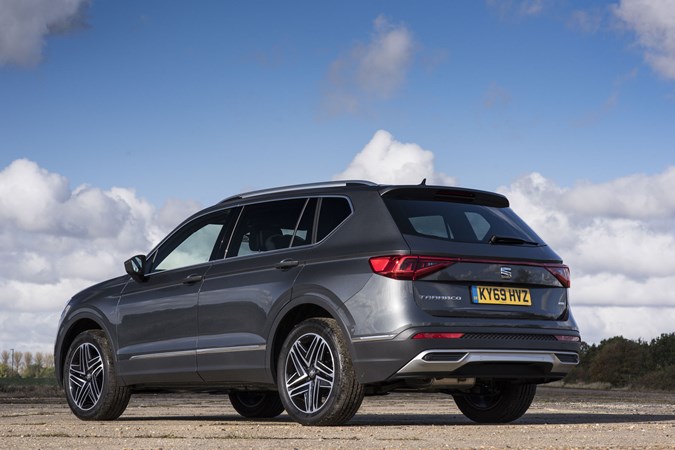
What’s more, the brown alcantara and sort of tweed fabric upholstery – brilliantly labelled Baza Grey – is an absolute joy, helping to lift what might otherwise be yet another slightly dour Volkswagen Group interior.
The cost of all this? £35,305. Is that a little eye-watering? I don’t think so for the amount of car involved.
So it’s got lots of toys, then?
I’m certainly not complaining. There’s not only a large touchscreen infotainment system in the centre console but a digital instrument cluster as well, meaning the sat-nav map can be displayed directly in front of me.
I can also choose from three different digital dial designs, which I find surprisingly amusing – I’ve gone for the least conventional one. Seems appropriate somehow.
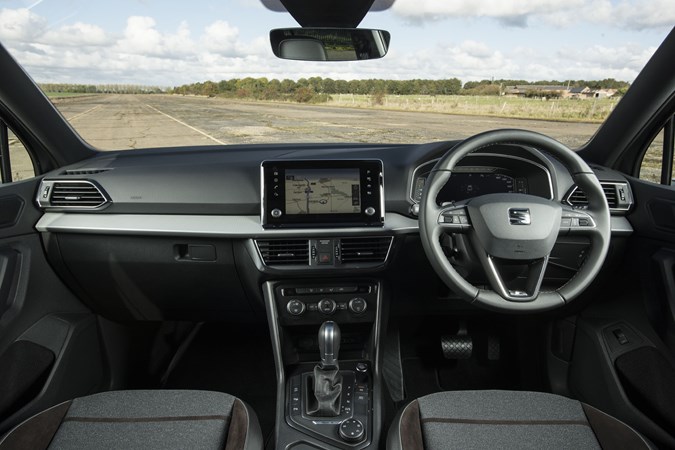
There are no worries as far as safety is concerned, either, with a full suite of active aids including adaptive cruise control, lane-keeping assist and autonomous emergency braking; so far these are all behaving themselves reasonably well, though I may have some further thoughts on this in a later report.
This Tarraco can also apparently park itself. But I haven’t had a reason to try this yet.
The only things that would make it better at this time of year are a heated windscreen for faster de-icing and some heated seats – though I suspect the groovy upholstery put the bosh on the latter, and I’m happy with the compromise on this occasion.
How are the first impressions?
Generally great. The styling is basically fine – if a little more Skoda to my eyes than SEAT, but perhaps that’s because the near identical Kodiaq was launched to market first – and despite the seven seats it’s not so big that it’s difficult to find parking space.
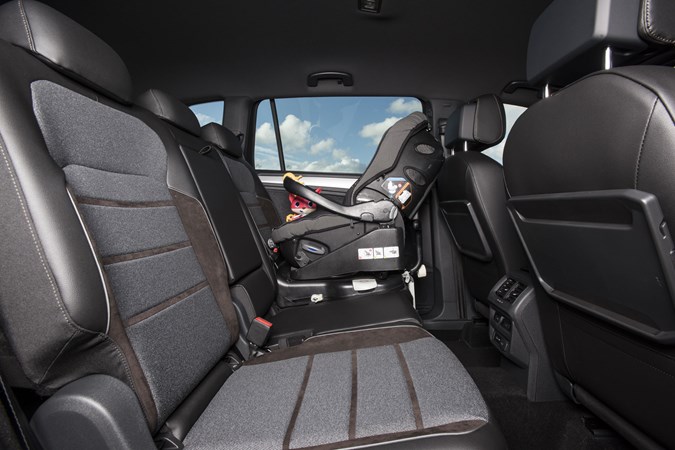
As with the previous Mazda, I was a little concerned about the relative lack of boot space, even with the third row of chairs folded, as they so far have been since day one. However, I then realised I could slide the centre row forward slightly, making just enough space to put the baby’s main buggy in lengthways – and there’s still plenty of passenger and Isofix car-seat space.
There’s no escaping how high up the boot floor is, which might cause some issues if you’ve got particularly heavy items to load. But at least there’s room inside the vehicle to stow the load cover if required, and I’m finding the cubby spaces in the corners surprisingly useful (they’ll take a full four-litre bottle of engine oil, which is handy if you’ve got another car that’s been drinking it like a toxic fish*).
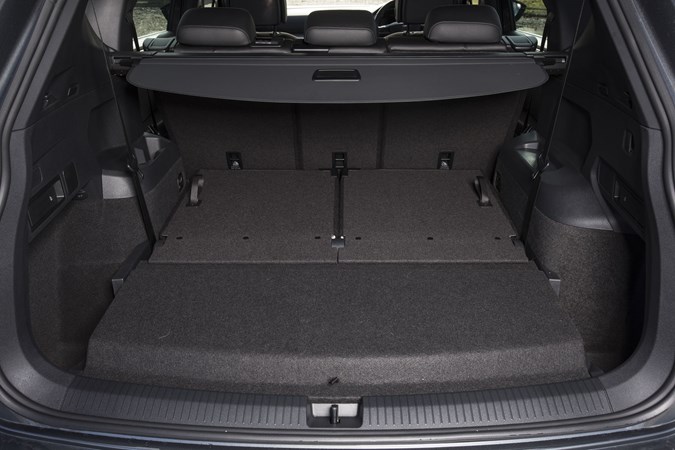
The driving experience is straightforward enough – easy controls, great visibility, enough performance at motorway speeds to be decisive when required – but the ride is once again firmer than I’d expected of a family-orientated machine.
Apparently this is one significant way the Tarraco is different to the Kodiaq, so I’ll aim to test an equivalent Skoda for direct comparison while I’ve got the SEAT. Still, the firmness leads to robust body control, keeping cornering lean well in check.
It’s likely the large 19-inch alloy wheels don’t help, either. In which case, thank goodness it’s not an Xcellence Lux model, which comes rolling on 20-inch dubs.
The best news is that the kiddo seems to like it more than the 6 Tourer. And as such, at this point in time, the biggest problem I’ve got with the Tarraco is remembering how to spell it.
More soon.
*That would be my Eunos Roadster; the engine has been changed now…
Update 2: Bang up to date
The Tarraco has been proving an outstanding family car thus far – the kiddo seems to like it, the versatile seating setup has been surprisingly useful already, and although I was initially non-plussed about the current, real-world calculated 37.6mpg, it turns out this isn’t at all far off the official claimed WLTP figure of 38.2-39.2mpg. And that’s just with regular driving.
But what’s impressed me the most recently is the strength of the windscreen.
Since this got unexpectedly stress-tested when something flew out of the back of a skip truck on the A1(M) the other morning.
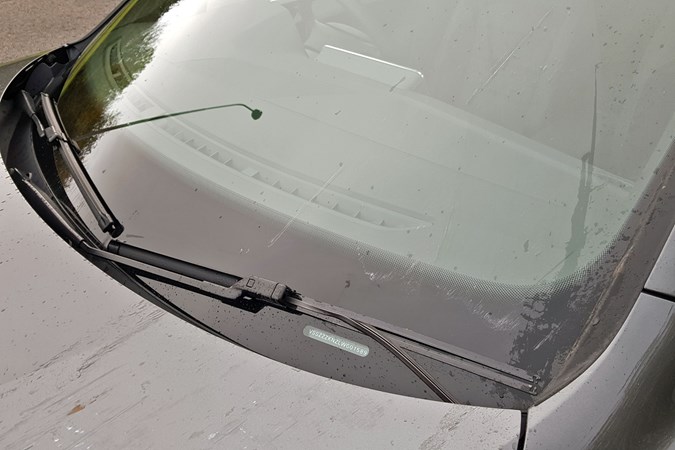
Watching the triangular piece of… something sailing through the air towards me was one of those classic slow-motion moments. In hindsight I wonder if I might have had time to swerve to avoid it, but given where I was at the time, I’m pretty happy with the mental processes that decided against that.
Anyway, it came down on the bonnet with a bang and then slammed into the windscreen, taking out the passenger-side wiper in the process. The more I think about it, the more I’m incredibly grateful the windscreen didn’t smash. And it didn’t, merely scuffed.
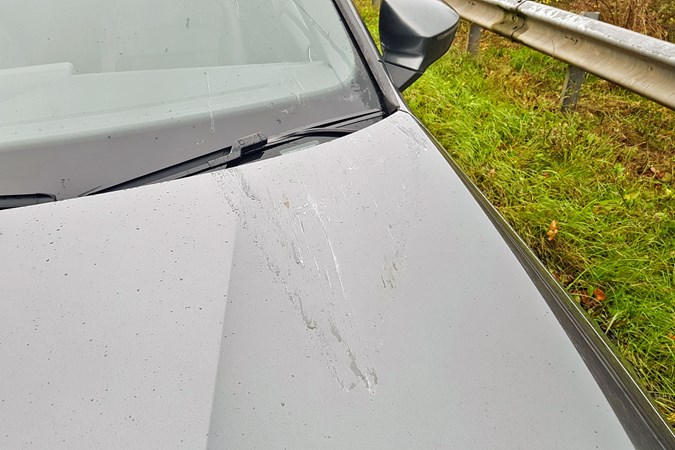
Similarly, the bonnet was more scratched than permanently disfigured. But the damage still wasn’t going to just polish out.
Fortunately, the skip truck did stop (after I’d chased it up the road for a while), and we were able to exchange details.
The SEAT is currently being repaired but will be back on Dad-car duties very soon.
Update 3: Ride, handling and performance
I’m writing this having just driven the Tarraco for the first time in quite a few days, during which I’ve spent at the wheel of various other vehicles, including a selection of vans, other SUVs and Lawrence’s Mazda 3 long-termer. Reason being, the absence and then being reunited has put the big SEAT into some unexpected perspective.
First things first, the damage to the front of the car caused by that errant piece of rubble that flew out of the back of a skip truck has been repaired. I’m no expert in this area, but to my eyes at least whatever’s been done is undetectable. Very smooth job by someone who clearly knows what they’re doing.
But has the absence made the heart grow fonder? Well, it’s certainly a comforting driving environment to come back to – although that’s perhaps as much to do with the way it drives like many other products in the Volkswagen Group product portfolio as it is the Tarraco’s particular capabilities. That’s not a criticism. There’s a lot to be said for the way VW and its off-shoots do things, it almost always produces cars that are good to drive in an easy-going and unflustered way.
Coming back to the SEAT after several days in other vehicles, however, a few things do stand out.
What’s the Tarraco like to drive?
Firstly it doesn’t stop with quite the immediacy I might like for a vehicle that’s capable of carrying seven people. I’m not sure if I just need to recalibrate myself to the pedal response or if my colleague Richard has been ragging the hell out of the car while I’ve been away on events (I suspect the former), but even with just me on-board I found myself having to press the brake pedal harder than I initially anticipated slowing down for the first major junction on my. Familiarity breeds good sense, I guess.

Secondly, the ride comfort – which I’ve mentioned before – continues to prove slightly disappointing. This is a firm experience, no doubt partly due to the size of the alloy wheels. It seems to have developed a minor vibration at A-road speeds, too, which I plan to get checked out at the local dealership in the not too distant future.
Regardless, the thudding, occasionally clattery interaction with any surface that isn’t super smooth continues to make me wonder if the Tarraco is really a good choice compared with the equivalent Skoda Kodiaq – is it possible that in an effort to inject some sporty Spanish character SEAT has gone a little too far? We’ve got a Kodiaq booked in for comparison, so I will report back.
For all that the suspension is firm, the Tarraco still has that upright SUV attitude that saps some of the pleasure from a challenging sequence of corners – it doesn’t take too much enthusiasm from your right foot to start generating lean angles that will soon begin to unsettle your passengers’ sense of calm. My toddler doesn’t seem to mind too much, but my wife is less of a fan.
On the other hand, perhaps this is also credit to the engine, which is my third and final area of observation for this report. The Tarraco’s 150hp doesn’t sound like much these days, and being generated by a 2.0-litre TDI that’s also at home in so many other VW products, it’s not got the sort of power unit that’s likely to get your heart racing.

Yet this is an often surprisingly fast car in the real world. While you do sometimes need to wake up the DSG transmission – the plastic paddleshifters are a constant disappointment here, but no more so than in, for example, an Audi R8 – this chunky 4x4 will pick up its skirt and really sprint if you ask it to. Certainly it makes the SkyActiv-X engine in the Mazda 3 seem lazy verging on dreadful.
The flip side to this is that it also has a natural cruising speed that seems to be higher than the national limit – particularly on the newly opened section of the A14, which is turning out to be a rather fast road, I’m finding I need to actively keep it in check. Fortunately, the car does have adaptive cruise control and a speed limiter as standard in this spec, so engaging either those is an instant solution to that particular pickle.
Anyway, enough said for now. I’ll update this section if my opinions change over the continuing course of life with this versatile SUV.
Update 4: Looking to lease a family SUV? The Tarraco looks like a bargain
It might seem daft to be talking about buying cars at this moment in time, as I write this from my dining room table, five weeks in the UK coronavirus lockdown. But I’ve been doing a lot of work on new sister site CarZing, which specialises in comparing cars by monthly fee – and this has caused me notice just how cheap you can lease a Tarraco just now.
This isn’t the result of an industry wide pandemic thing, either. Even compared to the cost of leasing the smaller SEAT Ateca or in-house seven-seater rival, the Skoda Kodiaq, the Tarraco is potentially a bargain.
Tarraco vs Ateca leasing cost
The cheapest Tarraco in our leasing section is £239 per month, with an initial payment of £2,000 and £199 processing fee. And that’s for a 150hp 1.5-litre turbo petrol engine, with DSG automatic transmission in very well equipped Xcellence spec.
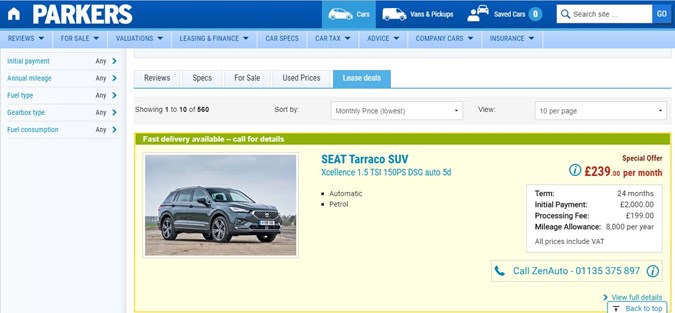
Ok, so it also only gives you 8,000 miles a year, but as it’s also only a 24-month contract, if you’re worried you’ll get bored with the car you won’t have to put up for it for very long.
Compare that with the cost of the cheapest SEAT Ateca available the same way at the same time, and you’d be looking at £265 a month for what is a smaller, less practical SUV, in a lower equipment level (SE) and a tiny 1.0-litre turbo petrol with just 115hp and a manual gearbox.
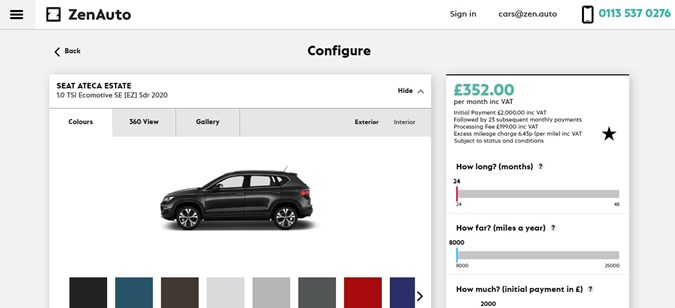
And although that’s with a £1,750 initial payment, it’s also a mammoth 48-month contract and the same 8,000 miles a year. Increase the initial payment to £2k and the monthly cost falls to £259 – still £20 more than the Tarraco – while if you want a 24-month contract on the Ateca you’re looking at £352 a month (and that’s with £2k initial – see ZenAuto for more details).
Tarraco vs Kodiaq leasing cost
The Tarraco looks even better value if you compare it with the Skoda Kodiaq – which is, as you probably remember, basically the same vehicle barring some branding and design details.
The cheapest Kodiaq in our leasing section does at least have the same 1.5-litre turbo petrol as the Tarraco detailed above. But you only get SE spec and a manual gearbox, and with £2,000 initial payment you’re still looking at £308 per month over 48 months – with the same 8,000-mile limit.

Want a 24-month contract, and the Skoda goes up to £365 a month – that’s £126 more every month than the better equipped SEAT. Although the DSG auto in the Tarraco might drink a little more fuel, on an 8,000-mile-a-year contract (assuming that’s a realistic distance for you) you’re hardly going to spend that amount more on dinosaur juice.
What about diesel?
Things do admittedly get much closer if you want a diesel – the difference between equivalent 150hp SE 4x4 DSG Skodas and SEATs drops to just £9 in favour of the Tarraco. This probably tells you something about how popular petrol SUVs are – though if you do want one, it’s clear the Tarraco is exceptionally good value right now.
Similarly, if you don’t want to lease, SEAT seems to routinely offer 0% finance on the Tarraco, as it is at the time of writing, while Skoda’s best offers are still around 3.9% at the moment.
Doesn’t sound like much, but over the contract term you’ll still end up paying more than the cash price of the Kodiaq should you opt to buy it at the end – and that’s despite a sizable ‘deposit contribution’ from Skoda. The Tarraco won’t accrue any interest, and therefore costs the same to finance buyers as it does to cash buyers.
What am I saying with all this? Just make sure you shop around.
Since we’ve been talking about finance, here’s some small print:
These deals are indicative examples of some packages available as at 21 April 2020, but are subject to change without prior notice. Everyone’s financial circumstances are different and the availability of credit is subject to status. Terms, conditions and exclusions apply. Parkers cannot recommend a deal for you specifically.
Bauer Consumer Media Limited is an appointed representative of ZenAuto Limited for the broking of regulated consumer hire agreements. ZenAuto Limited is authorised and regulated by the Financial Conduct Authority. ZenAuto Limited’s registered office is Number One, Great Exhibition Way, Kirkstall Forge, Leeds LS5 3BF. ZenAuto Limited’s company registration number is 10967345. ZenAuto is the trading name of ZenAuto Limited.
Update 5: SEAT Tarraco or Skoda Kodiaq – which is best?
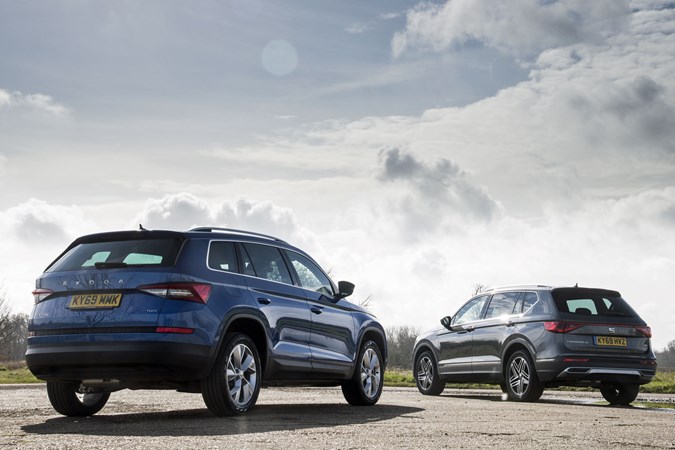
The last meaningful thing I was able to do with the Tarraco before lockdown was test it back-to-back with the equivalent Skoda Kodiaq.
These two vehicles were developed in parallel, and are essentially the same under the skin – the Skoda was launched first, however, and there seems to be a general sense that it is supposed to be a more comfortable interpretation of the seven-seater SUV brief, while the SEAT is supposed to be sportier.
The Kodiaq also has a number of ‘simply clever’ features, as befits the brand’s slogan, such as the handy umbrellas stored in the front doors. But it’s the comfort thing that I’m mostly interested in, as the Tarraco’s ride still feels a bit sharp to me, even after several thousand miles.

These two SUVs aren’t quite an exact match to each other. Both are 2.0-litre TDI turbodiesels with four-wheel drive and the DSG automatic transmission, but the Kodiaq has 190hp to the Tarraco’s 150hp, and while our Xcellence grade SEAT is near the top of the range, the Skoda is a mid-ranking Edition model.
Which is cheaper?
I don’t want to get bogged down in spec differences; the list of kit that comes with both is enormous, and you’re unlikely to feel short-changed by either. One notable difference, however, is that the SEAT has a digital instrument cluster as standard, while this ‘virtual cockpit’ is an optional extra fitted to this Skoda for £465. There’s a £340 Driver Assistance Package on the Kodiaq, too, which covers kit the Tarraco comes with anyway (the only option on our Tarraco is the paint).

What might surprise you is that the Skoda’s current list price is £39,960 before options, while the SEAT’s is £37,160 (ours was £35,505 when new); even the 190hp version of the SEAT is over a grand cheaper than this Skoda.
And don’t think the monthly leasing price claws back the difference for the Kodiaq. If you match power outputs, on the morning I’m writing this, the Tarraco Xcellence is around £60 a month cheaper than the Kodiaq Edition with the same 48-month contract terms, 10,000-mile annual limit and £3,000 initial payment. Do you still think of Skoda as a budget brand?
Is the Kodiaq more comfortable than the Tarraco?
Both of these SUVs are on 19-inch alloy wheels, and frankly I don’t think the Skoda offers any comfort advantages over the SEAT at all. It might be different if the Kodiaq was in off-road orientated Scout spec with its slightly different suspension, but spec-for-spec, the standard road versions have very little to choose between them.
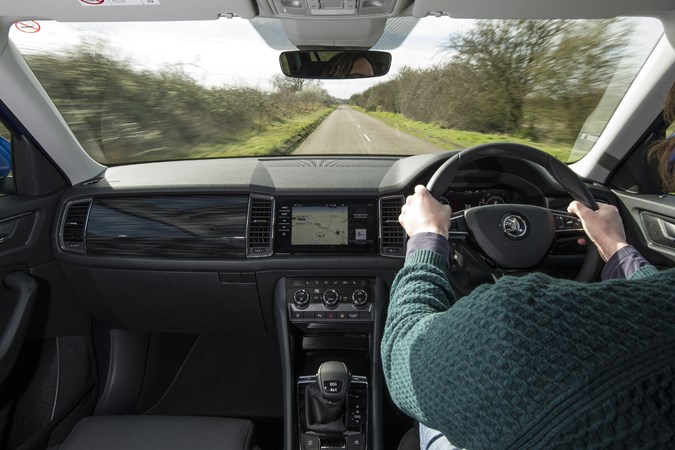
Pottering around at the sort of speeds these vehicles are most likely to find themselves plodding along, there’s not very much that’s different about the way these two drive at all. Push harder, and maybe the Skoda rolls a little more in the corners, but we’re really splitting straws here in terms of all the difference its going to make in daily family transport.
In fact, on the longer journeys we made in the Kodiaq, my wife complained that the middle rear seat row was less comfortable in the Skoda than the SEAT. Which seems odd, but they’re actually not the same design.
So which did you prefer?
The seats aren’t the only thing inside the Kodiaq that isn’t as nice as the Tarraco – I was surprised to discover that entire dashboard design is unique to each model, right down to the drive selector. And of the two, the Skoda has a more old-fashioned, conservative appearance to my eyes, and I found myself wishing I was behind the wheel of the SEAT with every mile I covered.
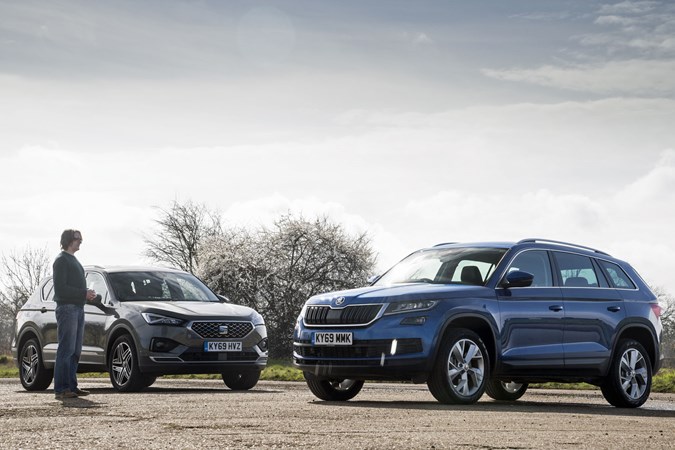
I wasn’t even bothered about the Kodiaq’s extra 40hp – seems the 150hp TDI is more than adequate for the needs of this kind of vehicle. Either that, or I really am getting old.
Update 6: Lockdown gremlins?
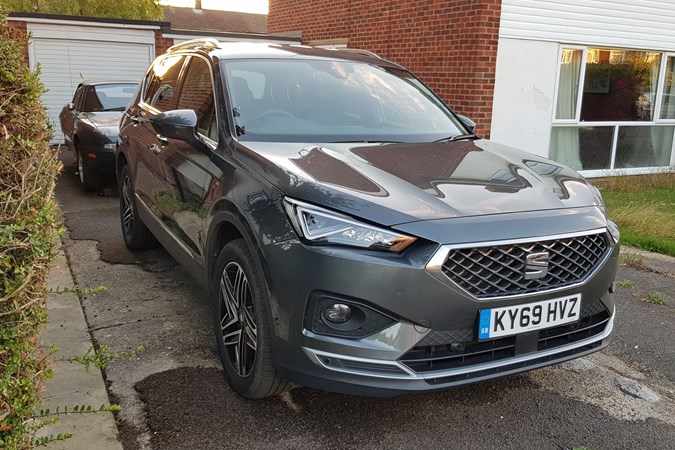
Well, this is without a doubt the strangest period of long-term test car ‘ownership’ that I have ever experience. As you’d probably expect, the coronavirus pandemic means that the Tarraco has spent the last three months pretty much doing nothing except sitting on my drive.
Curiously, it doesn’t seem to have liked this very much, as I’ve experienced a couple of minor electrical gremlins that hadn’t occurred while it was being used more regularly.
The first of these is an intermittent problem with the front parking sensors – in that roughly every other time I’ve fired it up for a trip across town to the supermarket, I’ve been greeted by an error warning message saying that they aren’t working.
While the big SEAT has literally been gathering dust, it’s hardly become filthy, so I don’t think it’s an issue with the sensors being obscured, which you sometimes get with very dirty cars. Rather I’ve got a vague feeling that it’s to do with the way it’s parked on the drive, which sees it spend most of its time pointed into the sun. Being such a minor, inconsistent thing, I hardly felt the need to trouble a dealer under lockdown, and once measures lifted enough for me to be able to start to use it again, the problem faded away. I promise you I wasn’t imagining it, though.
Then, one morning I got in, and the clock wasn’t displaying the right time. Which is odd, since this is controlled by the GPS signal, and I could check that this was active in the menus. It was almost as if the battery had died at some point – yet the car had unlocked and started, no problem. Switching the clock from automatic to manual and back again swiftly fixed that.
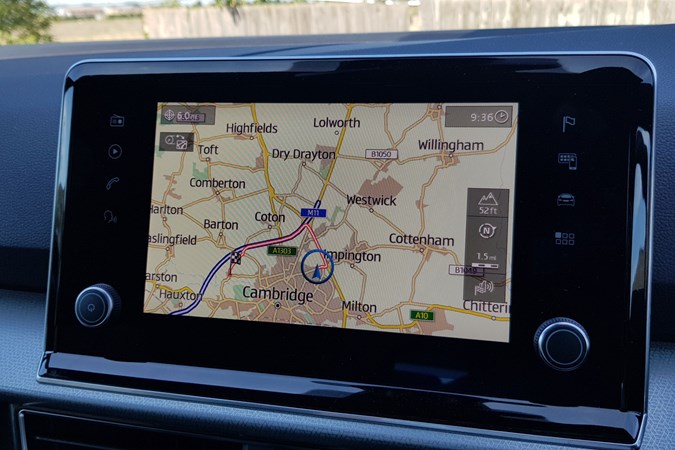
More bizarre still, on pretty much the first post-lockdown journey that required sat-nav, the sat-nav went slightly bonkers.
It was a weird bonkers, too. Our Tarraco has a digital instrument cluster, standard equipment on Xcellence spec. This cooperates with the central infotainment screen in an either/or fashion – by which I mean the mapping for the satellite-navigation appears either in the instrument cluster (which seems to be the default) or on the infotainment screen.
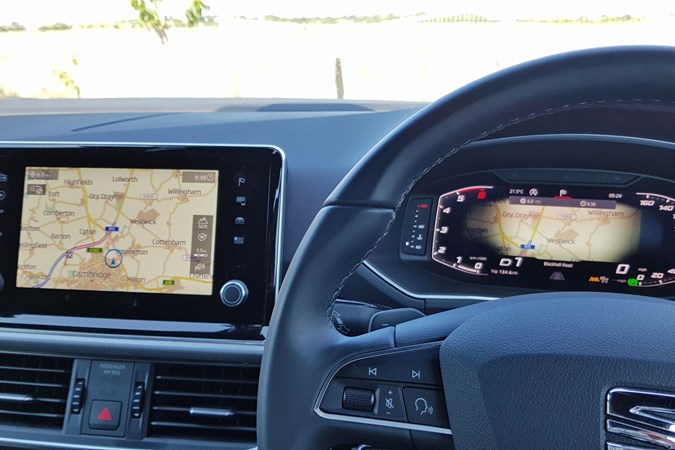
On starting it on this occasion, the map popped up on both. Odd, but not a big deal – until I noticed that the map on the in the cluster was centred properly, putting the position of the vehicle off the screen. Very odd, as if I’d accidentally accessed something like the ‘duplicate screen’ mode my laptop offers.
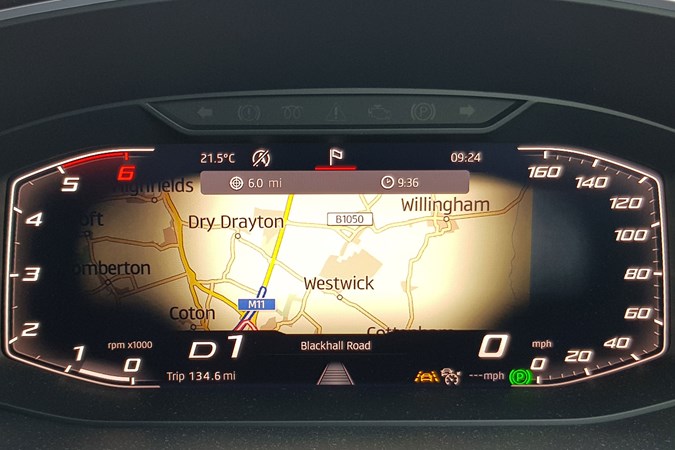
Again, this went away on the next ‘power cycle’ (IT-speak for off and on again, always makes me chuckle). None of these things made the Tarraco unusable, of course. But collectively they do make you wonder about the longevity of all those electronic components…
Then, of course, just to top off the SEAT’s lockdown woes, I managed to knock over the lawnmower and it fell into the door. This left the world’s smallest dent, but a dent nonetheless.
I always knew that gardening was dangerous.
Update 7: Goodbye
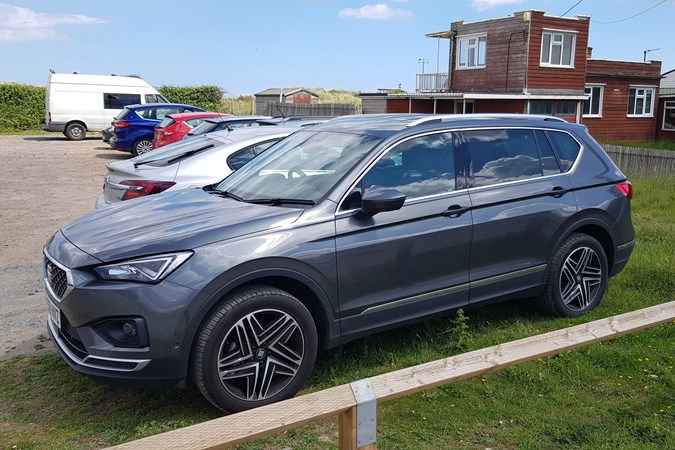
What a funny old time this has been. Looking at my fuel-tracking logs there was a period from February to June where I just didn’t put any juice in it at all, underlining that lockdown really did mean lockdown for the poor Tarraco.
But the gremlins that period seemed to generate aside, the lunky SEAT has been a hugely pleasant companion. The interior’s extra seats add a welcome amount of flexibility when required, the driving experience is sharp for a family SUV, and I like the way it looks inside and out. Chuck in some tremendously tempting finance deals (at least at the time of writing), and there seem to be very few reasons not to consider one very seriously.
When I was driving it regularly, fuel economy was consistently in the range of 37-38mpg – a good result for a large vehicle and a generally unsympathetic pilot. Performance always felt more than adequate, too.
So all around this has been something of a family car star, and I wouldn’t hesitate to recommend one.


